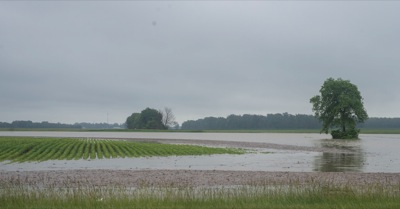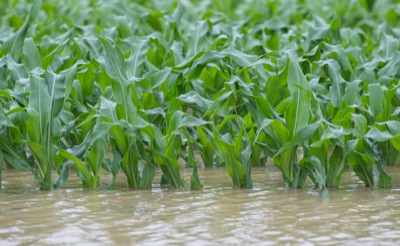Saturday, June 20th, 2015
Too soon to determine crop damage
Many farm fields near rivers and creeks remain submerged
By Nancy Allen

Photo by Mark Pummell/The Daily Standard
Water from Beaver Creek covers soybeans in a field along state Route 118 north of Coldwater in this photo taken Wednesday. Many area farm fields remained submerged on Friday. Area ag officials say only time will tell how much damage local crops sustained due to flooding.
Only time will tell how damaged local crops are from the recent flooding, local ag officials say.
"We've seen this movie before and the initial thought is that it's always worse than the result. We won't really know (the extent of the crop damage) until we get dried out and get some sunshine," said Chris Gibbs, executive director of the Mercer County Farm Service Agency.
Seven inches of rain fell this week, brining the monthly total so far to almost nine inches, Celina area forecaster Dennis Howick said. The average for June is 3.86 inches.
Wide swaths of farm fields abutting swollen creeks and rivers in both counties remain underwater, though it has begun to recede.
St. Marys farmer Greg Leffel estimated flooding has taken out the top 10 to 15 percent of his yields of corn, soybeans and wheat in the western part of Auglaize County in Noble Township.
"I got one river bottom field that out of 26 acres only about three acres isn't under water. That field (of soybeans) is probably done," he said. "The rest of my fields I have spots here and there."
Leffel said he applied nitrogen to his corn prior to recent rains and flooding, but fears much of it was lost. He plans to test plant tissue in a few weeks to determine if he needs to reapply more nitrogen.
"The big thing we really need is two weeks of dry, hot weather," he said. "I think a lot of (crops) would come out of it, but right now it really looks bad."
Gibbs agrees.
He plans to survey the county's crops in two to three weeks to get a better grasp of the situation.
Auglaize County OSU Extension Educator Jeff Stachler said yields will be diminished in varying degrees.
Corn can withstand longer periods of submergence than soybeans, but soybeans rebound better later in the season if damaged by flooding, officials said.
"We likely have lost the top end of the yield for corn and soybeans with as much flooding that's occurred," Stachler said. "But that does not mean we won't be close to that."
It's too late in the growing season to replant corn, but there is still time to replant soybeans, officials said.
"If someone can spot-in soybeans until the middle of July, they'll end up with something," Gibbs said.
Between 10 to 20 percent of hay remains unharvested in both Mercer and Auglaize counties.
"That is a very sad situation," Stachler said. "Between 10 and 20 percent wasn't even made for a first cutting and now we've got people that cut early and should be making a second cutting and they are going to be put behind."
Many dairy and cattle producers grow their own hay to feed their livestock.
Hay that becomes too mature looses feed quality and is more difficult to harvest because it gets long and lies down in the field.
"The hay people have been more impacted by the weather in May and June than the corn and soybean people have," Stachler said. "Fields near rivers and creeks received the most flooding and will remain saturated the longest."
The wheat crop in both counties is also a big question mark.
Wheat is usually ready for harvest around July 4, which is just two weeks away. Excessive moisture makes the crop vulnerable to fungus, Stachler said.
Stachler said when he looked at his county's wheat crop about three weeks ago, it was some of the most disease-free wheat he had ever seen. That changed.
"When I was out on (June 11) I did some head scab which has vomitoxin, the one we have to worry about," he said.
Vomitoxin is produced by fungus on wheat and cannot be tolerated in high amounts by farm animals.
"There is some anxiety that we might see some significant levels of vomitoxin," Stachler said. "The worst case scenario is elevators reject it and the best case scenario is they (farmers) get docked on the price."
Stachler noted that higher ground that normally produces lower yields in periods of normal rainfall could produce better this year.
Gibbs urged producers to contact their crop insurance agents and local FSA offices before destroying or replanting any crops that are damaged by flooding.
"Even if the damage is small, that needs to be reported to your crop insurance agent," he said. "There may be other perils later in the season that compound the flooding that could generate a claim. You need to report each peril as it comes."
Gibbs noted the new farm bill does not contain any natural disaster programs that could help farmers whose crops are damaged by flooding. Emergency USDA loans are available to farmers, but only if a federal disaster declaration is made.
Gibbs said he doesn't know if a federal disaster declaration is forthcoming. He plans to monitor the crops in the county for damage and reassess them in about two to three weeks.
"We're a long way from that," he said.
Theresa Dirksen, Mercer County Soil and Water Conservation District engineer said there have been no reports of farmers' manure holding structures overflowing.

Photo by Mark Pummell/The Daily Standard
This corn on state Route 118 north of Coldwater was submerged in several inches of water on Wednesday.

